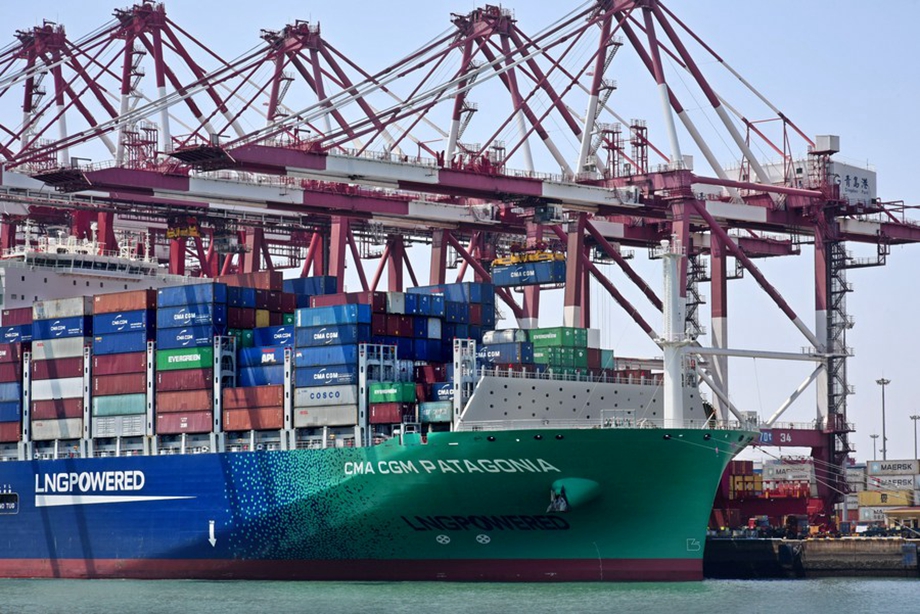China's exports expected to keep stable growth
 Photo taken on May 1, 2022 shows a container vessel docking at the Qianwan Container Terminal in Qingdao, East China's Shandong province. [Photo/Xinhua]
Photo taken on May 1, 2022 shows a container vessel docking at the Qianwan Container Terminal in Qingdao, East China's Shandong province. [Photo/Xinhua]
Data shows strong upward momentum in country's trade recovery, expert says
China's exports are expected to maintain stable growth during the second half of the year as trade activity continues to vitalize, providing stronger support to overall economic expansion, according to trade experts and economists on Wednesday.
Their comments came as the General Administration of Customs said on Wednesday that China's exports surged by 13.2 percent year-on-year to hit 11.14 trillion yuan ($1.66 trillion) in the first half of the year-picking up from an 11.4 percent increase in the first five months.
Imports rose 4.8 percent year-on-year to a value of 8.66 trillion yuan, also quickening from a 4.7 percent increase in the January-May period.
That lifts the trade value for the first half of the year to 19.8 trillion yuan, up 9.4 percent year-on-year, or 1.1 percentage points higher than the rate in the first five months.
"The data have demonstrated a strong upward momentum in trade recovery," said Zhang Yansheng, chief researcher at the China Center for International Economic Exchanges.
"It seems that export growth will likely achieve the forecast many analysts made at the start of the year, to register a yearly surge of around 10 percent this year despite multiple challenges," he added.
The nation will also likely retain a considerable trade surplus in 2022, although geopolitical conflicts, the expected pullback from economic stimulus in developed economies, and the continuing COVID-19 pandemic will add uncertainties to global demand, he said.
According to Customs data, imports and exports combined rose 14.3 percent year-on-year in June, registering a strong pickup from the 9.5 percent increase in May, and much stronger than the 0.1 percent growth in April.
Moreover, China's trade with major trading partners maintained steady growth during the first half of the year.
Its trade value with the United States increased by 11.7 percent year-on-year during that period, while that with the Association of Southeast Asian Nations increased by 10.6 percent and with the European Union by 7.5 percent.
Liu Ying, a researcher at the Chongyang Institute for Financial Studies at Renmin University of China, predicted that China's foreign trade is likely to exceed 40 trillion yuan this year, with pro-growth policy measures in place to further unleash the potential of the nation's complete and resilient manufacturing system.
"The steady expansion in China's foreign trade will provide important impetus for overall economic growth," she said, adding that the nation's firm upholding of multilateralism and free trade will help reinforce global trade liberalization and facilitation to benefit consumers and enterprises worldwide.
Chen Jia, a researcher at the International Monetary Institute of Renmin University of China, said that China's trade expansion in the first half of the year, which beat expectations, will not only benefit the nation but also help curb high inflation around the world.
He said he expected that global demand for quality and relatively cheap Chinese goods will remain strong, as prices of energy and consumer products are persistently high in many economies.
Zheng Houcheng, director of the Yingda Securities Research Institute, said that a highly anticipated rollback of some US tariffs on Chinese goods would also facilitate China's export growth.
However, Zhang, with the China Center for International Economic Exchanges, said that all the tariffs must be removed to bring real economic benefits to consumers and enterprises.
He also said China must unwaveringly pursue transformation and upgrades in industrial and supply chains, to gain a firmer footing for economic growth, with more development in the high-tech manufacturing and services sectors.
Business executives have also expressed hope for a more facilitating environment, with less disruption from anti-globalization forces.
Wu Dazhi, president of the Guangzhou Leather & Footwear Association, said some Chinese enterprises in the labor-intensive industry have been stepping up research and development and establishing overseas factories, amid protectionist trade measures by the US and some European countries and increasing labor costs in China.
Such moves will catalyze the transformation of Chinese enterprises to gain better positions on the global industrial and supply chains, he said.